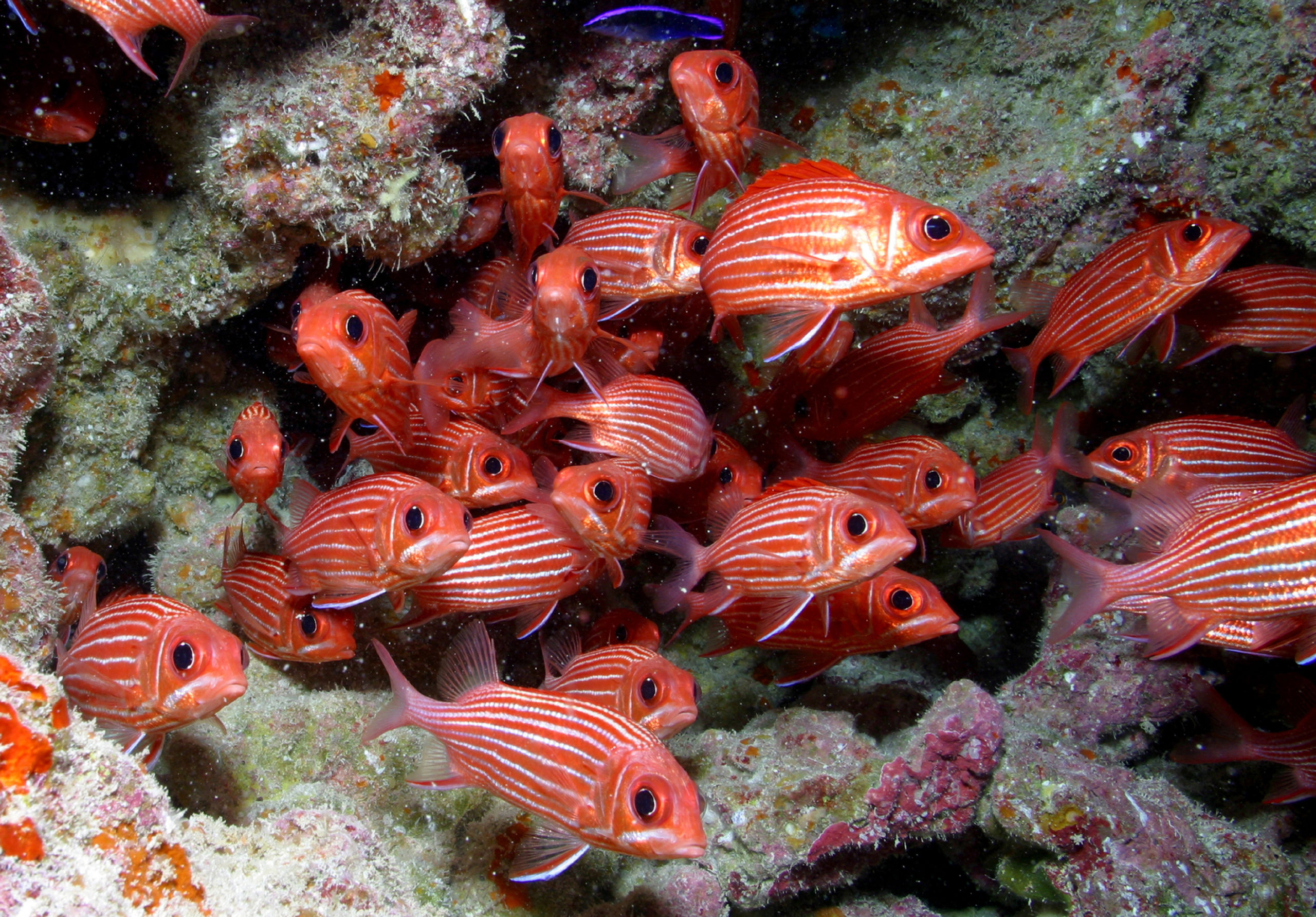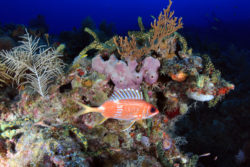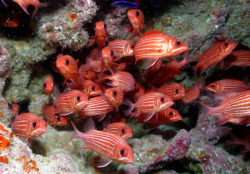
Sea Wonder: Squirrelfish

Photo: Greg McFall
Squirrelfish (Holocentrus sp.) hardly look like small woodland creatures with bushy tails that live in trees and collect acorns. The 150 known species of squirrelfish that call the world’s ocean home are brightly colored fish that live in rocky habitats or on coral reefs and are often featured in aquarium displays. So how did they get their name? It’s all in the eyes. Squirrelfish have large, squirrel-like eyes that help them see at night.
Description
Squirrelfish differ in appearance by species but have a number of traits in common. They generally share features like vibrantly colored bodies that have a shine to them, disproportionately large, black eyes, and lighter colored bellies that help them blend into their environments when viewed from below. Squirrelfish are medium sized with the largest species reaching maximum lengths of nearly two feet, but most are less than a foot long. Some species, like the longspine squirrelfish, have sharp spines that secrete poison and serve as a defense mechanism.
Diet & Habitat

A school of red Hawaiian squirrelfish, or ‘ala‘ihi, at Papahānaumokuākea Marine National Monument. Photo: James Watt/NOAA
Squirrelfish live in rocky areas of the ocean and on coral reefs. They can live at depths of nearly 600 feet but are most commonly found living at depths of 100 feet or less. In the National Marine Sanctuary System, species of squirrelfish live in Florida Keys, Flower Garden Banks, and Hawaiian Islands Humpback Whale national marine sanctuaries. In Hawai’i, the Hawaiian Squirrelfish is the most commonly sighted reef fish.
These fish are nocturnal carnivores that feed on meroplankton – crustacean larvae and juvenile crustaceans. Their upper jaw positioning helps them to dig for their dinner in sandy bottom areas and seagrass beds. During the day, squirrelfish hide in dark crevices to rest and avoid predation by larger fish like eels, mahi mahi, mutton snapper, and tuna. Some species of squirrelfish have the ability to produce low frequency sounds with the muscles that make the rib bones around their swimbladders to vibrate. These sounds may help them communicate with one another and possibly deter predators.
Life History
Squirrelfish reproduce by external fertilization throughout the year in tropical waters; in cooler parts of the ocean they only reproduce during the summer months. Females can lay thousands of eggs at a time and do not provide any parental care to their offspring once they hatch. Most juveniles do not survive into adulthood, but those that do mature when they grow to be about half of their adult size. They are slow to grow and have a fairly long lifespan compared to other fish, living as long as five years in some cases. Social structures and behaviors vary greatly between species, but juvenile squirrelfish tend to swim in schools while adults are more solitary.
Threats & Conservation
Squirrelfish are edible but are small in size and can survive in traps for unusually long periods of time, so they aren’t fished for consumption on a large scale. South American artisanal fisheries, particularly in Brazil and Venezuela, do commonly target squirrelfish. Due to their unique appearance, size, and resilience, squirrelfish are commonly fished for the aquarium trade. Most squirrelfish populations are considered healthy or have not been evaluated by the International Union for Conservation of Nature (IUCN). While they are not considered threatened or endangered, their habitats are vulnerable to warming waters, ocean acidification, physical trauma from fishing gear and ships, pollution, and coastal development.

Squirrelfish in Flower Garden Banks National Marine Sanctuary. Photo: GP Schmahl/NOAA
